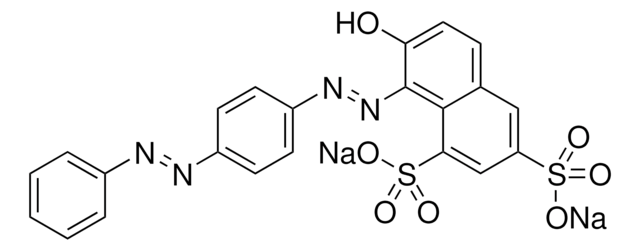210439
Acid Blue 113
Dye content 50 %
About This Item
Prodotti consigliati
Forma fisica
powder
Composizione
Dye content, 50%
λmax
566 nm
ε (coefficiente d’estinzione)
≥18000 at 563-569 nm in H2O at 0.02 g/L
applicazioni
diagnostic assay manufacturing
hematology
histology
Temperatura di conservazione
room temp
Stringa SMILE
[Na+].[Na+].[O-]S(=O)(=O)c1cccc(c1)\N=N\c2ccc(\N=N\c3ccc(Nc4ccccc4)c5c(cccc35)S([O-])(=O)=O)c6ccccc26
InChI
1S/C32H23N5O6S2.2Na/c38-44(39,40)23-11-6-10-22(20-23)34-35-27-16-17-28(25-13-5-4-12-24(25)27)36-37-29-18-19-30(33-21-8-2-1-3-9-21)32-26(29)14-7-15-31(32)45(41,42)43;;/h1-20,33H,(H,38,39,40)(H,41,42,43);;/q;2*+1/p-2/b35-34+,37-36+;;
XPRMZBUQQMPKCR-XGQONITOSA-L
Descrizione generale
Codice della classe di stoccaggio
11 - Combustible Solids
Classe di pericolosità dell'acqua (WGK)
WGK 1
Punto d’infiammabilità (°F)
Not applicable
Punto d’infiammabilità (°C)
Not applicable
Certificati d'analisi (COA)
Cerca il Certificati d'analisi (COA) digitando il numero di lotto/batch corrispondente. I numeri di lotto o di batch sono stampati sull'etichetta dei prodotti dopo la parola ‘Lotto’ o ‘Batch’.
Possiedi già questo prodotto?
I documenti relativi ai prodotti acquistati recentemente sono disponibili nell’Archivio dei documenti.
I clienti hanno visto anche
Il team dei nostri ricercatori vanta grande esperienza in tutte le aree della ricerca quali Life Science, scienza dei materiali, sintesi chimica, cromatografia, discipline analitiche, ecc..
Contatta l'Assistenza Tecnica.











